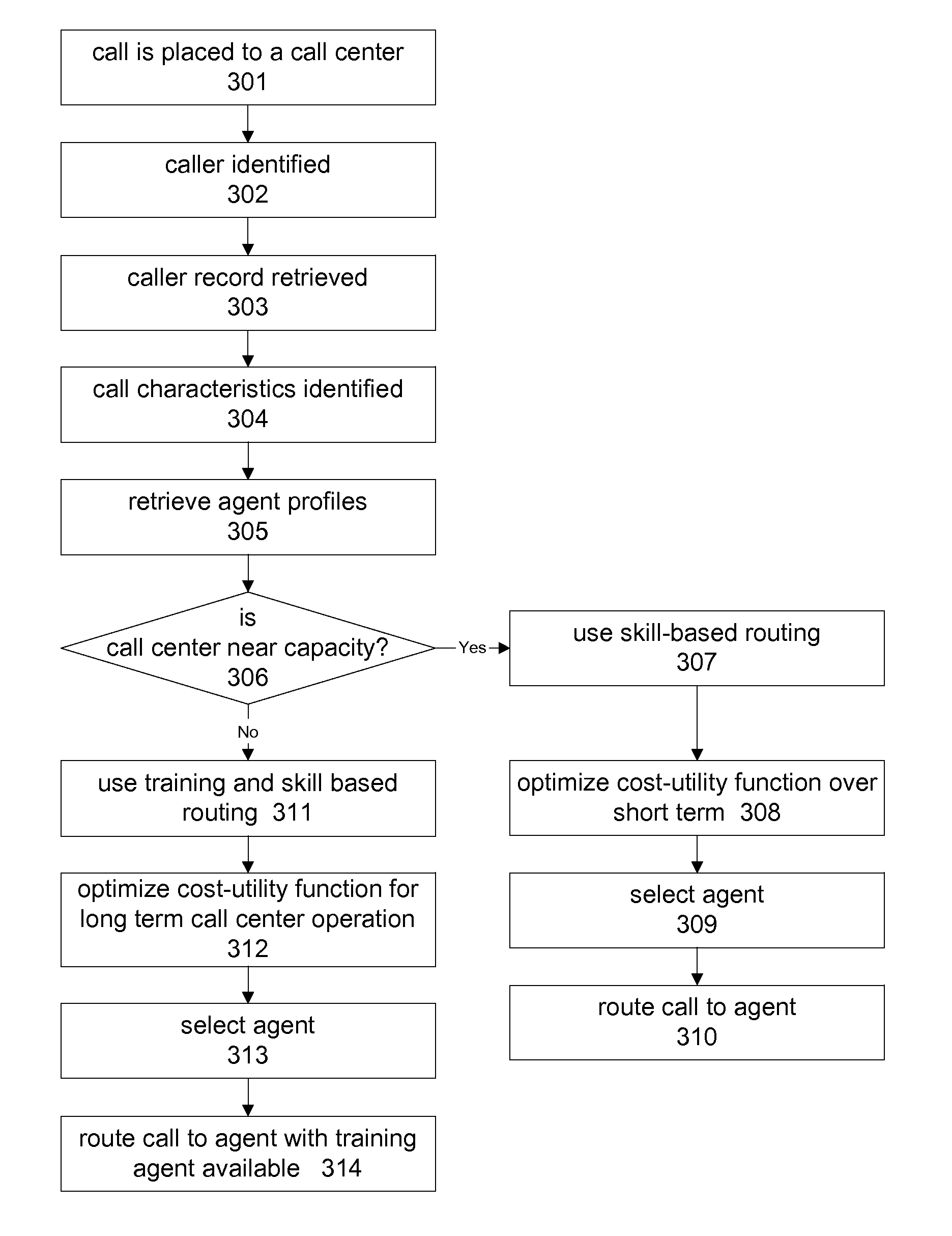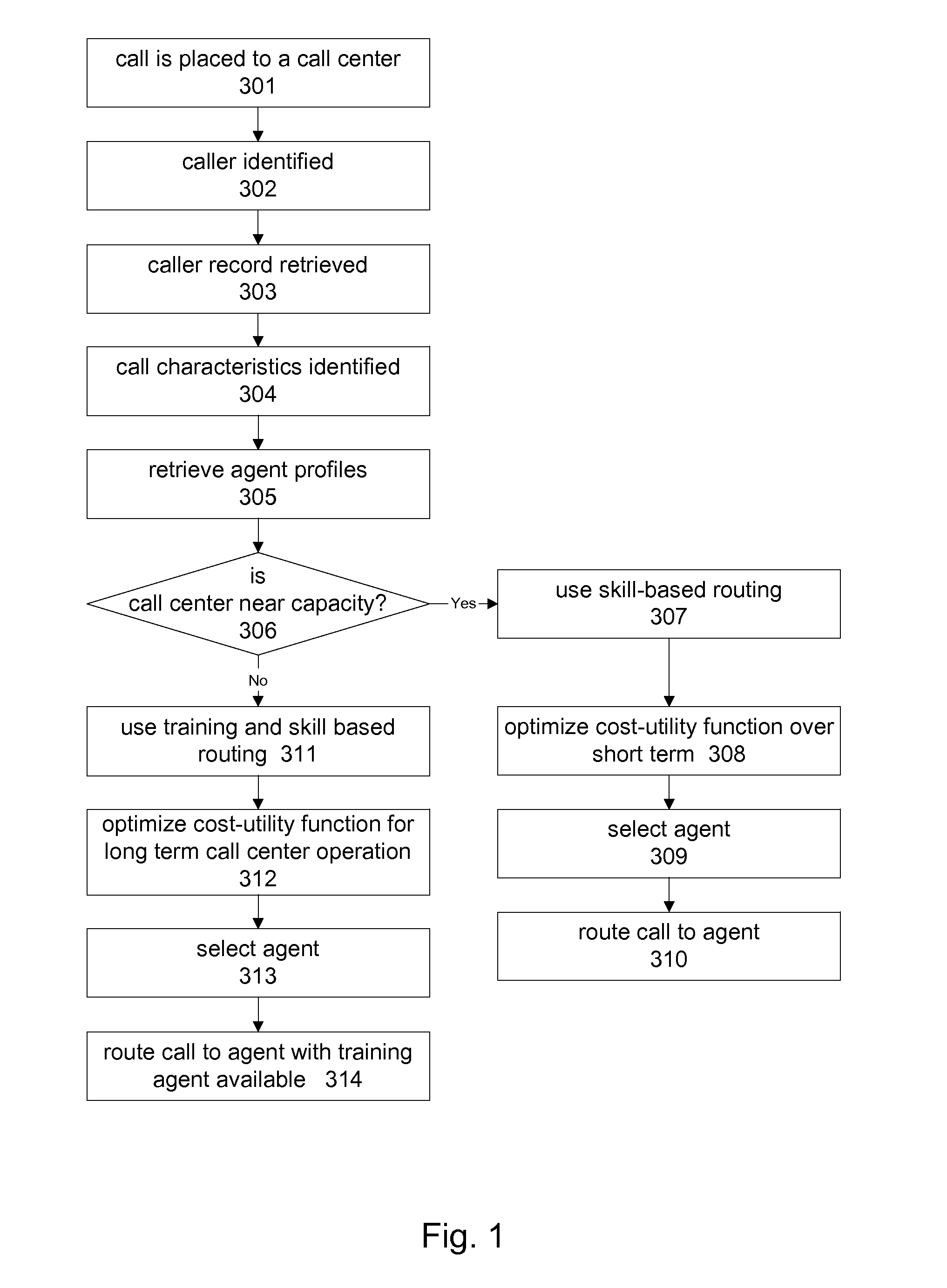Thus, the communications process is generally unburdened from tasks requiring a high degree of intelligence, for example the evaluation of complex algorithms and real time optimizations.
However, as is well known, non-deterministic operating systems, such as Windows 2000, are subject to significant latencies, especially when multiple tasks are executing, and when contention exists between resources, especially hard disk access and
virtual memory.
On the other hand, externalizing essential functions imposes potential latencies due to communications and external
processing.
ACD systems experience high traffic periods and low traffic periods.
However, in many call center environments, the agents are not equally adept at performing all types of transactions.
As another example, some transactions may require the expertise of ‘specialists’ having training in the specific field to which the transaction relates, since training all agents to be knowledgeable in all areas would be cost-prohibitive.
For ACD applications in which agents are not equally adept at performing all transactions, there are a number of problems which at least potentially reduce transactional
throughput of the call center.
The under-skilled agent problem reduces transactional
throughput when the switch routes transactions to ACD agents who do not have sufficient skills to
handle the transactions.
Consequently, neither the agent's nor the customer's time is efficiently utilized.
Inefficient utilization is also a concern related to the over-skilled agent problem.
Call-management may also designate certain agents as ‘specialists,’ since it would be cost prohibitive to
train all agents to be experts in all transactions.
However, if a significant time passes without transactions that require
highly skilled agents, the agents may be assigned to calls for which they are over-qualified.
There are a number of potentially negative effects of static grouping.
This may be a costly process requiring extensive analysis and
data entry.
Secondly, the configuration that is devised is not likely to be optimal in all situations.
Thirdly, when a new product is released, the devised configuration likely will be less valuable.
This requires the time and attention of call center managers and supervisors.
In a skills-based routing environment, the ‘matching’ of calls to agents by the ACD becomes more sophisticated and thus complicated.
However, ‘skills based’ ACD agent groups are often small and, as a result, whenever an inbound call arrives, all such ‘skills based’ ACD agents may be busy.
Scheduling of agents in a skills-based environment is thus a much more difficult problem than it is in a
queue / team environment.
Thus, for example, a heavy volume of Service calls might place higher demands on multi-skilled agents, causing an unforeseen shortage of coverage for Billing calls.
Further, agents with different skills cannot be considered interchangeable for call handling.
Thus, trading lunch times between a Sales-only agent and a multi-skill agent might lead to over-
staffing Sales at
noon while under-
staffing Service at 1:00 p.m.
This would lead to undesirable results.
All agents having a particular combination of skills may be deemed a ‘skill group.’ A central problem of skills-based scheduling is then finding a way to predict what fraction of scheduled agents from each skill group will be available to each call type during each time interval being scheduled.
Unfortunately, it is difficult or impossible to calculate the skill group availability fractions directly.
Particularly as ACD skills-based routing algorithms themselves evolve and become more sophisticated, the factors affecting skill group availability become too complex for
direct analysis.
Within a single split, the agents may be limited to knowledge of different subtypes of transactions.
While the Kohler et al. patent does not directly address the problems associated with static groups, it does consider the skills of the individual agents.
Predominately, however, the routing plans supported by the carriers are static in the sense that they do not automatically react to unexpected variations in incoming
call volume or distribution, nor to actual call delays being experienced at each destination.
If the
system places outbound calls expecting the agent to be available, but the agent instead places their own call to another agent or a supervisor, or has an incoming call connected to them, the outbound system may not have an agent available to
handle an answered outbound call.
Additionally, if an agent is assigned to
handle incoming calls, but instead places a call to another agent or listens to voice mail messages, the number of queued incoming calls may increase, thereby increasing the
waiting time experienced by the callers.
Even so, certain users may selectively
exploit known technological limitations and artifacts of the auction system, including non-real time updating of bidding information, especially in the final stages of an auction.
It is for this reason that so-called proxy bidding, wherein the bidder creates a preprogrammed ‘strategy’, usually limited to a maximum price, are disfavored.
A maximum price proxy bidding system is somewhat inefficient, in that other bidders may test the proxy, seeking to increase the bid price, without actually intending to purchase, or contrarily, after testing the proxy, a bidder might give up, even below a price he might have been willing to pay.
Thus, the proxy imposes inefficiency in the system that effectively increases the transaction cost.
However, this lack of
determinism may upset coordinated schedules, thus impairing efficient business use of the auction system.
This system, however, lacks real-time performance under many circumstances, having a stated refresh period of 10 seconds, with a
long latency for confirmation of a bid, due to constraints on
software execution,
quality of service in communications streams, and bid confirmation dialogue.
Thus, it is possible to lose a bid even if an attempt was made prior to another bidder.
The need to quickly enter the bid, at risk of being too late, makes the process potentially error prone.
However, proxy bidding undermines some of the efficiencies gained by a live market.
Further, after a purchase is indicate, the user's screen is not updated, obscuring the ultimate lowest selling price from the user.
However, if the user maintains a second browser, he can continue to monitor the auction to determine whether the product could have been purchased at a lower price, and if so, fail to confirm the committed purchase and purchase the same goods at a lower price while reserving the goods to avoid risk of loss.
Thus, the system is flawed, and may fail to produce an efficient transaction or optimal price.
This system employs HTTP, and thus does not automatically update remote terminal screens, requiring the e-mail notification feature.
On the other hand, if a certain sales volume is exceeded in a specified period of time, the system may automatically increase the price.
For transactions of high
monetary value, the cost of
polling approaches that of the on-line schemes, but for micropayments, the cost of
polling is a small increase over the traffic incurred by the off-line schemes.
The theory underlying this
micropayment scheme is that the monetary units are small enough such that risks of failure in transaction closure is relatively insignificant for both parties, but that a user gets few chances to default before credit is withdrawn.
 Login to View More
Login to View More  Login to View More
Login to View More 


